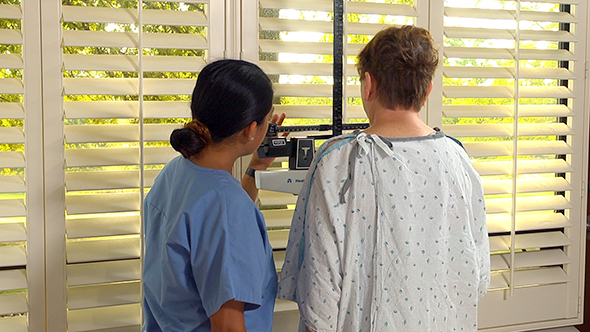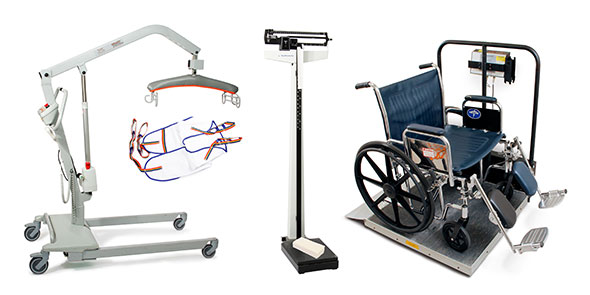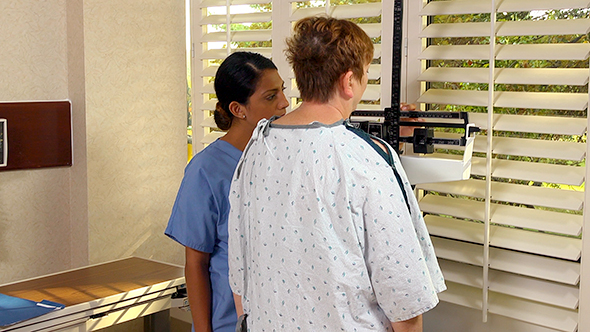Measurements and Vital Signs
Select a Skill:
- » Measuring Weight and Height
- » Taking a Radial Pulse
- » Taking an Apical Pulse
- » Counting Respirations
- » Taking a Temperature with an Electronic Thermometer
- » Measuring Blood Pressure
- » Using a Pulse Oximeter
Take the Review Test:

Purpose

- Weight and height are measured on admission to the agency. Then the person is weighed daily, weekly, or monthly. This is done to measure weight gain or loss.
- Standing scales are common. Chair, wheelchair, bed, and lift scales are used for persons who cannot stand. Follow the manufacturer’s instructions and agency procedures.
- When measuring weight and height, follow these guidelines:
- The person wears only a gown or pajamas. Clothes add weight. No footwear is worn. Footwear adds to the weight and height measurements.
- The person voids before being weighed. A full bladder adds weight.
- A dry incontinence product is worn. A wet product adds weight.
- Weigh the person at the same time of day. Before breakfast is the best time. Food and fluids add weight.
- Use the same scale for all weight measurements. Scales weigh differently.
- Balance the scale at zero before weighing the person. For balance scales, move the weights to zero. A digital scale should read at zero.
Equipment
Roll cursor over items to see labels. For the purposes of clearly depicting the equipment, a barrier is not shown in this photo. When providing care, a barrier should always be placed on the surface before placing the equipment.

Lift scale
Standing scale
Wheelchair scale
Paper towels (for standing scale)
Delegation
- Follow delegation guidelines. Before measuring weight and height, obtain this information from the nurse and care plan:
- When to measure weight and height
- What scale to use
- When to report measurements
- What patient or resident concerns to report at once
Preparation

- Observe quality-of-life measures.
- Review the information under Delegation and Safety and Comfort.
- Ask the person to void.
- Practice hand hygiene.
- Bring the scale and paper towels (for a standing scale) to the person’s room.
- Identify the person. Check the ID bracelet against the assignment sheet. Also call the person by name.
- Provide for privacy.
Safety

- Follow the manufacturer’s instructions when using chair, wheelchair, bed, or lift scales. Also follow the agency’s procedures.
- Practice safety measures to prevent falls.
Comfort
- The person wears only a gown or pajamas for the weight measurement. Prevent chilling and drafts.
Procedure Video
Audio Description: OFFFollow-up Care

- Provide for comfort.
- Place the call light within reach.
- Raise or lower bed rails. Follow the care plan.
- Unscreen the person.
- Complete a safety check of the room.
- Discard the paper towels.
- Return the scale to its proper place.
- Practice hand hygiene.
Reporting/Recording
- Report and record your measurements.
Review Questions
Select the best answer.
1. Before weighing a person, what should you do?
 Ask the person to remove all of his or her clothing
Ask the person to remove all of his or her clothing Have the person void so that the bladder is empty
Have the person void so that the bladder is empty Ask what the person’s normal weight is to determine a baseline
Ask what the person’s normal weight is to determine a baseline Check with the family to determine if the person can safely stand on the scale
Check with the family to determine if the person can safely stand on the scale
Select the best answer.
2. When is a chair, wheelchair, bed, or lift scale used?
 When the person cannot stand
When the person cannot stand When the nearest standing scale is broken
When the nearest standing scale is broken When a more precise weight measurement is needed
When a more precise weight measurement is needed When the person requests the use of a different scale
When the person requests the use of a different scale
Select the best answer.
3. When is the best time to weigh a person?
Select the best answer.
4. After weighing a person on admission, how frequently may you have to repeat the measurement?
Select the best answer.
5. How should you record the person’s height?
You have completed the Review Questions for this skill. To take the Review again select the Start Over button. To proceed to another skill select from the dropdown menu. Select the Home or Back button to proceed to the next section.

